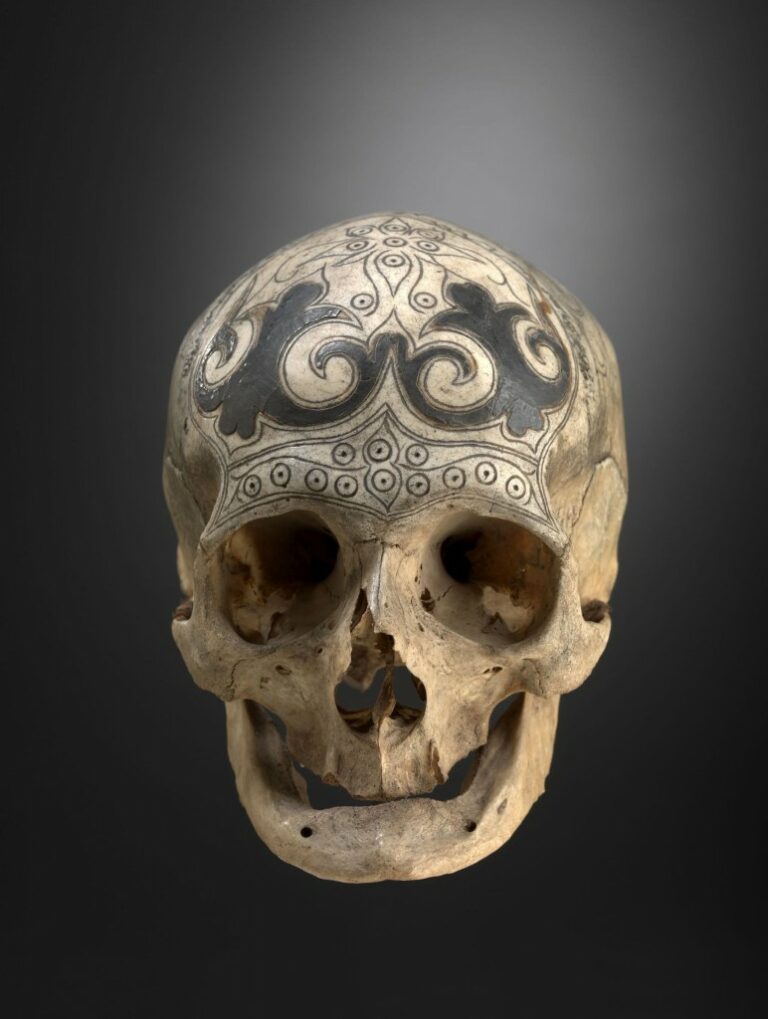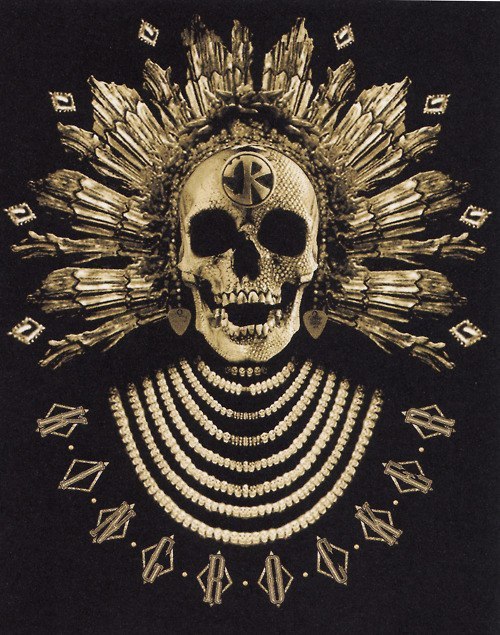Meaning
Mictlantecuhtli, also known as “Lord of the Place of the Dead,” was a powerful deity in Aztec mythology who ruled over the underworld, Mictlan.
His name is derived from Nahuatl words: “Mictlan,” meaning “place of the dead,” and “Teuctli,” meaning “lord” or “ruler.” Therefore, his name translates literally to “Lord of the Place of the Dead.”
Mictlantecuhtli was a formidable figure, often depicted with a skeletal visage, adorned in ceremonial attire, and wielding a staff.
He was considered a grim but essential deity, responsible for guiding souls to their final resting place. His role extended beyond simply overseeing the afterlife; he also held power over diseases, death, and even earthquakes.
The Aztecs believed Mictlantecuhtli resided in the depths of Mictlan, a vast underworld composed of nine distinct levels, each representing different aspects of the deceased’s journey. His rule was absolute, and his domain was feared by both the living and the dead.
Here are some key attributes associated with Mictlantecuhtli:
1.
Ruler of the Underworld: Mictlantecuhtli’s primary domain was Mictlan, where he held absolute authority over souls who had passed from the earthly realm.
2.
God of Death: While not directly associated with causing death, Mictlantecuhtli was the embodiment of death itself and presided over its inevitability.
3.
Master of Disease and Earthquakes: His influence extended beyond the afterlife, as he was also believed to control epidemics and cause tremors in the earth.
4.
Guardian of the Dead: Mictlantecuhtli protected souls on their journey through Mictlan and ensured they reached their final resting place.
The Aztecs held elaborate rituals and ceremonies to honor Mictlantecuhtli, often making offerings to appease him and ensure a safe passage for the deceased into his realm.
Mictlantecuhtli, a name reverberating with power and solemnity, holds deep significance within Aztec mythology. It translates to “Lord of the Place of the Dead,” offering a glimpse into the central role death and the underworld played in their worldview.
The Aztecs believed that existence wasn’t linear but cyclical, encompassing both life and death as intertwined aspects. Death wasn’t an end but a transition, a journey into the realm of Mictlan, the land of the dead ruled by Mictlantecuhtli.
Mictlan was envisioned as a perilous underworld divided into nine levels, each representing a different aspect of death and decay. It was a harsh and desolate place, reflecting the fear and reverence associated with death in Aztec culture.
Mictlantecuhtli, as the ruler of this domain, embodied both power and fear. He was depicted as a skeletal figure, clad in jaguar skin and adorned with bones, a visual representation of death’s dominion over all living beings.
He wielded immense authority, presiding over the souls of the departed and determining their fate in the afterlife. His role wasn’t purely malevolent; he was also seen as a protector of the dead, ensuring they underwent proper rituals and traversed the treacherous underworld safely.
The name Mictlantecuhtli itself highlights this duality. “Mictlan” refers to the realm of death, while “Teuctli” signifies lordship or rule. Thus, the name encapsulates both the power and responsibility associated with overseeing the afterlife.
Understanding Mictlantecuhtli’s significance is crucial for comprehending the Aztec worldview. He represented not only the inevitability of death but also the cyclical nature of existence and the profound connection between life and the underworld.
Origin
Mictlantecuhtli’s name delves deep into the heart of Aztec cosmology, reflecting their intricate understanding of life, death, and the underworld.
The term “Mictlantecuhtli” is a compound word derived from Nahuatl, the language spoken by the Aztecs. It breaks down as “Mictlan,” meaning “the place of the dead,” and “Teuctli,” which signifies “Lord.”
Thus, Mictlantecuhtli translates to “Lord of the Underworld” or “Ruler of Mictlan.”
Mictlan was a crucial concept in Aztec mythology, representing the final destination for all souls after death. It wasn’t simply a place of eternal darkness but a complex realm with its own hierarchy, geography, and deities.
Aztec mythology viewed the underworld as a series of nine levels, each with unique characteristics and challenges that souls had to endure upon their arrival.
Mictlantecuhtli presided over this underworld, overseeing the journey of souls and ensuring order within its depths.
His power extended beyond mere rule; he was believed to have dominion over death itself, determining the fate of individuals after they left the mortal realm.
Visual representations of Mictlantecuhtli often depicted him as a skeletal figure adorned with ornaments befitting his regal status.
He carried a club and wore a necklace of human skulls, symbolizing his dominion over death and the souls dwelling in his realm.
His name evokes both fear and respect, reflecting his immense power and the weighty responsibility he bore within Aztec cosmology.
Mictlantecuhtli, whose name translates to “Lord of the Place of the Dead,” was a central deity in **Aztec religion**. He reigned over Mictlan, the Aztec underworld, a realm of darkness and cold.
The origin of Mictlantecuhtli’s name is directly tied to his domain. “Mictlan” refers to the underworld itself, a place where souls journeyed after death. “Teuctli” signifies “lord” or “master,” indicating Mictlantecuhtli’s absolute dominion over this realm.
Mictlantecuhtli was considered both fearsome and revered. He was depicted as an emaciated figure, often adorned with elaborate bone jewelry and skulls, reflecting the harsh realities of his domain.
While he held power over death, Mictlantecuhtli wasn’t solely a deity associated with negativity. He played a role in maintaining the balance between life and death, ensuring the continuation of the universe.
In Aztec cosmology, death was not seen as an ending but as a transition to another realm. The journey through Mictlan was arduous, filled with perils and challenges that souls had to overcome to reach their final destination.
Mictlantecuhtli’s role extended beyond his domain in the underworld. He was also associated with fertility and agriculture, demonstrating the interconnectedness of life, death, and renewal within Aztec belief systems.
His complex nature and multifaceted role highlight the sophistication of **Aztec religion**, which viewed death not as an end but as a vital part of the cyclical nature of existence.
History
Mictlantecuhtli is a Nahuatl word that translates to “Lord of the Place of the Dead.” He was a major deity in Aztec mythology, ruling over the underworld known as Mictlan.
The name’s etymology provides insight into his dominion.
* “Mictli”: refers to “the dead” or “the place of death.”
* “Tecuhtli”: signifies “lord” or “ruler.”
Together, they create a potent image of Mictlantecuhtli as the supreme authority over the realm of the departed.
Depictions and iconography solidify this association. He is often portrayed as a skeletal figure, emphasizing his connection to death and decay.
Some representations showcase him adorned with funerary symbols like skulls, bones, and feathered headdresses, further reinforcing his role as the master of Mictlan.
He is frequently depicted alongside his consort, Mictlantecuhtli, who represents the realm’s goddess. Their combined imagery suggests a duality within the underworld, encompassing both the fearsome aspects of death and its potential for continuation.
The significance of Mictlantecuhtli extends beyond his role as a ruler.
He embodies the cyclical nature of life, death, and rebirth, crucial concepts in Aztec cosmology. His dominion over Mictlan ensured the proper journey of souls after death, emphasizing the importance of honoring ancestral spirits and maintaining balance between the worlds of the living and the dead.
Understanding Mictlantecuhtli’s name, depictions, and iconography offers a glimpse into the intricate beliefs and practices surrounding death in Aztec culture. He represents not just the end but also a transformation, highlighting the cyclical nature of existence and the interconnectedness of life and death.
Mictlantecuhtli, a name that resonates with both power and fear, holds significant weight in Mesoamerican mythology. Derived from Nahuatl, the language spoken by the Aztecs, the name translates to “Lord of the Place of the Dead,” revealing his central role in their understanding of the afterlife.
This underworld deity’s origins can be traced back to earlier civilizations that predate the Aztec Empire. While specific details remain shrouded in time, evidence suggests Mictlantecuhtli emerged from a shared Mesoamerican belief system centered around death and rebirth. His dominion over the realm of the dead was a concept prevalent throughout various cultures, reflecting the universal human fascination with mortality.
The Aztecs, known for their sophisticated art and literature, profoundly influenced by Mictlantecuhtli’s mythology.
Artistic representations depicted him as a skeletal figure, adorned with jaguar pelts and carrying the staff of death. These depictions emphasized his association with decay and transformation, serving as a reminder of the inevitability of death.
Literary works, such as the Aztec creation myth and codices dedicated to the underworld, provided intricate narratives about Mictlantecuhtli’s realm and his interactions with souls departing from the mortal world.
These stories explored themes of sacrifice, judgment, and the cyclical nature of life and death, reflecting the Aztecs’ complex understanding of these profound concepts.
The influence of Mictlantecuhtli extends beyond Aztec culture. His name and imagery appear in the art and mythology of neighboring civilizations, showcasing the interconnectedness of Mesoamerican beliefs surrounding death and the afterlife.
- 30 Best B2B Leads Database Providers to Try in 2025 - April 26, 2025
- Best Clay Alternatives for 2025 - April 26, 2025
- Best Lusha Alternatives for 2025 - April 26, 2025


